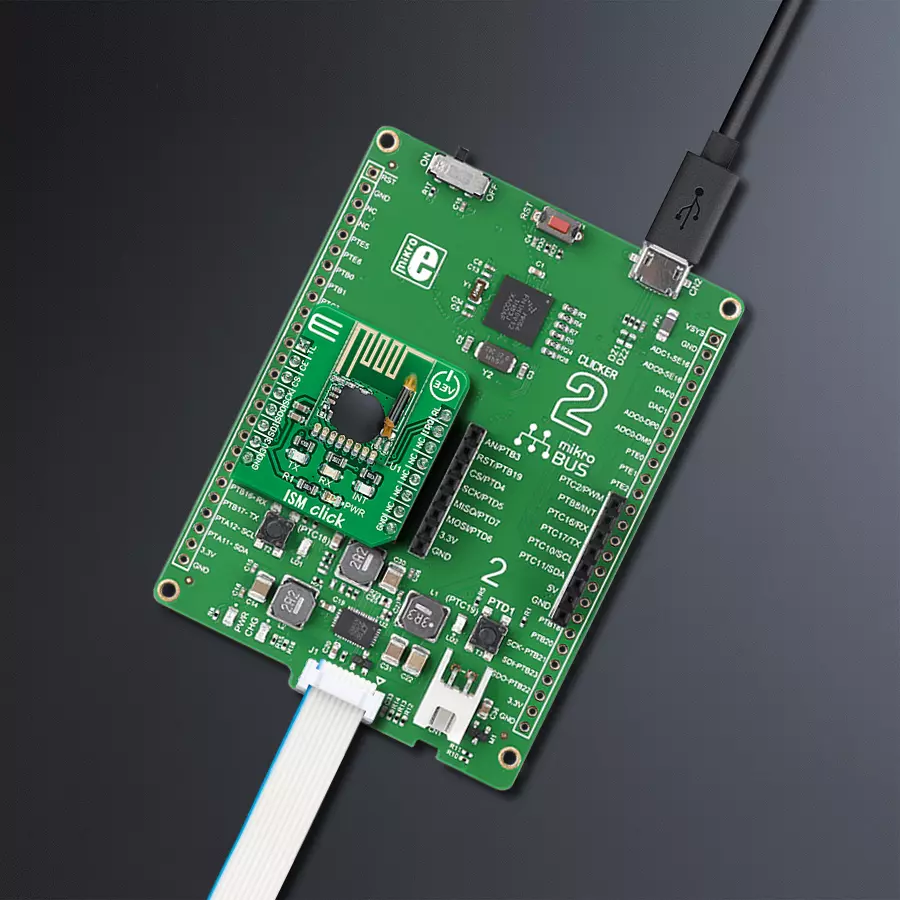释放您解决方案的潜力,实现高效、快速和可靠的无线通信。
A
A
硬件概览
它是如何工作的?
ISM Click基于RF Solutions的RFM75,这是一款低功耗、高性能的2.4GHz GFSK收发器,工作在全球ISM频段2400MHz至2527MHz。RFM75以TDD模式运行,可作为发射机或接收机。突发模式传输和高达2Mbps的空中数据速率使其适用于超低功耗应用。嵌入式数据包处理引擎使得整个操作只需一个简单的MCU作为无线电系统。自动重传和自动确认功能可在没有任何MCU干预的情况下提供可靠的链路。发射机和接收机必须使用相同的RF信道频率进行通信,支持可编程的空中数据速率为250Kbps、1Mbps或2Mbps。RF信道频率
决定了RFM75使用的信道的中心。RF_CH寄存器在寄存器组0中设置频率,按照以下公式计算F0= 2400 + RF_CH(MHz),其中RF信道频率的分辨率为1MHz。ISM Click通过标准SPI串行接口与MCU通信,该接口的工作时钟速率可高达8 MHz。在省电模式下,RFM75处于睡眠模式,功耗极低。在此模式下,SPI接口仍然活动,通过SPI接口可访问所有寄存器值。此外,此Click板上还有一个黄色LED指示灯,路由到mikroBUS™插座的INT引脚上(在成功接收数据包后为用户提供反馈),以及一个芯片使能功能,路由到mikroBUS™插座
的RST引脚上,用于激活RFM75的TX或RX模式。此外,它还有两个额外的LED指示灯,一个红色和一个蓝色LED,路由到mikroBUS™插座的AN和PWM引脚上。用户可以在发送或接收数据时使用它进行可视指示。此Click板™只能使用3.3V逻辑电压电平操作。在使用具有不同逻辑电平的MCU之前,必须对板上执行适当的逻辑电压电平转换。但是,该Click板™配备了一个包含函数和示例代码的库,可用作进一步开发的参考。
功能概述
开发板
Clicker 2 for Kinetis 是一款紧凑型入门开发板,它将 Click 板™的灵活性带给您喜爱的微控制器,使其成为实现您想法的完美入门套件。它配备了一款板载 32 位 ARM Cortex-M4F 微控制器,NXP 半导体公司的 MK64FN1M0VDC12,两个 mikroBUS™ 插槽用于 Click 板™连接,一个 USB 连接器,LED 指示灯,按钮,一个 JTAG 程序员连接器以及两个 26 针头用于与外部电子设备的接口。其紧凑的设计和清晰、易识别的丝网标记让您能够迅速构建具有独特功能和特性
的小工具。Clicker 2 for Kinetis 开发套件的每个部分 都包含了使同一板块运行最高效的必要组件。除了可以选择 Clicker 2 for Kinetis 的编程方式,使用 USB HID mikroBootloader 或外部 mikroProg 连接器进行 Kinetis 编程外,Clicker 2 板还包括一个干净且调节过的开发套件电源供应模块。它提供了两种供电方式;通过 USB Micro-B 电缆,其中板载电压调节器为板上每个组件提供适当的电压水平,或使用锂聚合物 电池通过板载电池连接器供电。所有 mikroBUS™ 本
身支持的通信方法都在这块板上,包括已经建立良好的 mikroBUS™ 插槽、重置按钮和几个用户可配置的按钮及 LED 指示灯。Clicker 2 for Kinetis 是 Mikroe 生态系统的一个组成部分,允许您在几分钟内创建新的应用程序。它由 Mikroe 软件工具原生支持,得益于大量不同的 Click 板™(超过一千块板),其数量每天都在增长,它涵盖了原型制作的许多方面。
微控制器概述
MCU卡片 / MCU

建筑
ARM Cortex-M4
MCU 内存 (KB)
1024
硅供应商
NXP
引脚数
121
RAM (字节)
262144
使用的MCU引脚
mikroBUS™映射器
“仔细看看!”
Click board™ 原理图

一步一步来
项目组装
实时跟踪您的结果
应用程序输出
1. 应用程序输出 - 在调试模式下,“应用程序输出”窗口支持实时数据监控,直接提供执行结果的可视化。请按照提供的教程正确配置环境,以确保数据正确显示。

2. UART 终端 - 使用UART Terminal通过USB to UART converter监视数据传输,实现Click board™与开发系统之间的直接通信。请根据项目需求配置波特率和其他串行设置,以确保正常运行。有关分步设置说明,请参考提供的教程。

3. Plot 输出 - Plot功能提供了一种强大的方式来可视化实时传感器数据,使趋势分析、调试和多个数据点的对比变得更加直观。要正确设置,请按照提供的教程,其中包含使用Plot功能显示Click board™读数的分步示例。在代码中使用Plot功能时,请使用以下函数:plot(insert_graph_name, variable_name);。这是一个通用格式,用户需要将“insert_graph_name”替换为实际图表名称,并将“variable_name”替换为要显示的参数。

软件支持
库描述
该库包含 ISM Click 驱动程序的 API。
关键功能:
ism_cfg_setup- 配置对象初始化函数。ism_init- 初始化函数。ism_default_cfg- Click 默认配置函数。
开源
代码示例
完整的应用程序代码和一个现成的项目可以通过NECTO Studio包管理器直接安装到NECTO Studio。 应用程序代码也可以在MIKROE的GitHub账户中找到。
/*!
* @file main.c
* @brief Ism Click example
*
* # Description
* This library contains API for the ISM Click driver.
* This example transmits/receives and processes data from ISM Clicks.
*
* The demo application is composed of two sections :
*
* ## Application Init
* Initializes driver and performs the default configuration.
*
* ## Application Task
* Transmitter/Receiver task depends on uncommented code.
* Receiver logging each received byte to the UART for data logging,
* while transmitter send messages every 1 second.
*
* @author Nenad Filipovic
*
*/
#include "board.h"
#include "log.h"
#include "ism.h"
// Comment out the line below in order to switch the application mode to receiver
#define DEMO_APP_TRANSMITTER
static ism_t ism;
static log_t logger;
static uint8_t demo_message_1[ 9 ] = { 'M', 'i', 'k', 'r', 'o', 'E', 13, 10, 0 };
static uint8_t demo_message_2[ 12 ] = { 'I', 'S', 'M', ' ', 'C', 'l', 'i', 'c', 'k', 13, 10, 0 };
void application_init ( void )
{
log_cfg_t log_cfg; /**< Logger config object. */
ism_cfg_t ism_cfg; /**< Click config object. */
/**
* Logger initialization.
* Default baud rate: 115200
* Default log level: LOG_LEVEL_DEBUG
* @note If USB_UART_RX and USB_UART_TX
* are defined as HAL_PIN_NC, you will
* need to define them manually for log to work.
* See @b LOG_MAP_USB_UART macro definition for detailed explanation.
*/
LOG_MAP_USB_UART( log_cfg );
log_init( &logger, &log_cfg );
log_info( &logger, " Application Init " );
// Click initialization.
ism_cfg_setup( &ism_cfg );
ISM_MAP_MIKROBUS( ism_cfg, MIKROBUS_1 );
if ( SPI_MASTER_ERROR == ism_init( &ism, &ism_cfg ) )
{
log_error( &logger, " Application Init Error. " );
log_info( &logger, " Please, run program again... " );
for ( ; ; );
}
ism_default_cfg ( &ism );
Delay_ms ( 100 );
#ifdef DEMO_APP_TRANSMITTER
ism_switch_tx_mode( &ism );
log_printf( &logger, " Application Mode: Transmitter\r\n" );
#else
ism_switch_rx_mode( &ism );
log_printf( &logger, " Application Mode: Receiver\r\n" );
#endif
log_info( &logger, " Application Task " );
}
void application_task ( void )
{
#ifdef DEMO_APP_TRANSMITTER
ism_transmit_packet( &ism, ISM_CMD_W_TX_PAYLOAD_NOACK, demo_message_1, 9 );
log_printf( &logger, " Tx : %s", demo_message_1 );
Delay_ms ( 1000 );
ism_transmit_packet( &ism, ISM_CMD_W_TX_PAYLOAD_NOACK, demo_message_2, 12 );
log_printf( &logger, " Tx : %s", demo_message_2 );
Delay_ms ( 1000 );
#else
uint8_t rx_buf[ ISM_MAX_PACKET_LEN ] = { 0 };
ism_receive_packet( &ism, &rx_buf[ 0 ] );
if ( rx_buf[ 0 ] )
{
log_printf( &logger, " Rx : %s", rx_buf );
}
#endif
}
int main ( void )
{
/* Do not remove this line or clock might not be set correctly. */
#ifdef PREINIT_SUPPORTED
preinit();
#endif
application_init( );
for ( ; ; )
{
application_task( );
}
return 0;
}
// ------------------------------------------------------------------------ END
































